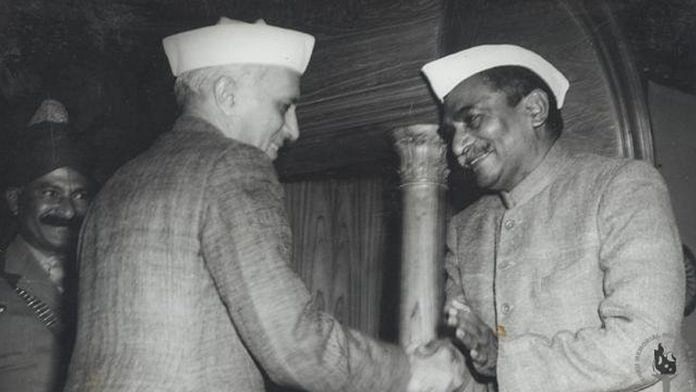New Delhi: History is often cruel to the quiet ones, and India’s first President Rajendra Prasad, or Rajen babu as he was known, has borne the price of his reserved practicality.
By 2009, school students in Patna, Bihar — Prasad’s birth-state — were failing to place his face in the hallowed halls of our history books when shown a black-and-white photograph. Prime ministers rarely meet the same fate.
Now, 56 years after his death on 28 February, 1963, the act of writing about his life has become an exercise of remembrance. As hate and disharmony fuelled by political agendas continue to polarise the world, Prasad’s vision of an Independent India is worth remembering more than ever.
“India has never prescribed or prosecuted opinion and faith… Our philosophy has room as much for a devotee of a personal god, as for an agnostic or an atheist,” he said at Rashtrapati Bhavan after the country was formally declared a Republic in 1950.
“We shall, therefore be only implementing in practice under our Constitution what we have inherited from our traditions namely, freedom of opinion and expression.”
A freedom fighter, academic, Congressman, humanitarian, journalist, lawyer and the only two-term President in India’s history, Prasad’s multifaceted expertise made him “a man amongst men” as Mahatma Gandhi called him.
Also read: Nehru didn’t want Rajendra Prasad as the Republic’s first president. Then Sardar intervened
A journey to President
Born to a family of humble origins in the Saran district of Bihar on 3 December 1884, Prasad’s early childhood was spent learning from a local Maulvi because his village did not have a primary school. His father Mahadev Sahay — an eminent scholar — and his deeply-religious mother Karnaleshwari Devi created a home environment that inculcated ideals of selfless service, purity, sacrifice and humility in Prasad from a very early age.
Despite the lack of access to mainstream educational institutes and a child marriage at the age of 13 to Rajbanshi Devi, Prasad’s dedication to a pursuit of knowledge led him to Presidency College, Calcutta, where “he was elected by a huge margin to the post of Secretary of the College Union,” a Lok Sabha profile of his reads.
Prasad’s granddaughter Tara Sinha would later come to say that “after he appeared for one of his examinations, the checked answer sheet he received carried the remark the ‘examinee is better than the examiner’.”
But Rajen babu’s life had a different plan for him.
Political career
In 1917, Prasad was greatly moved by the spirited leadership of Gandhi in the Champaran Satyagraha, organised to liberate the Indigo planters from exploitation at the hands of the British. Three years later, when the Non-Cooperation movement was officially passed by Indian National Congress in 1920 in response to the Rowlatt Act (1918) and subsequent Jallianwalla Bagh massacre of 1919, Prasad forfeited his flourishing law practice in Calcutta to join the political struggle full time.
Prasad had already become a member of the Indian National Congress in 1911 after completing his studies, but after 1920, he came into his own with regards to efforts in mobilising the masses towards India’s fight against British colonisation. He organised tours through his home state of Bihar, working closely with people on the ground to understand their sentiments and champion their dormant impulse towards a right to self-rule.
Prasad was imprisoned twice in his lifetime. The first being after the salt satyagraha in 1930, after which he was prematurely released in 1934 because the government just couldn’t do without him. An earthquake had left Bihar reeling, and Prasad’s release was pivotal in organising relief efforts — in which he managed to raise a significant sum of Rs 38 lakh. As a consequence of his efforts, he was elected president of the Congress for the first time in 1935.
In 1942, as a part of the Quit India movement, Prasad was imprisoned again — this time for a period of three years.
Stoic, but strong
By 1946, when the historic Constituent Assembly was responsible for the task of drafting free India’s Constitution, Rajen babu was called upon in his capacity as presiding officer of the constituent assembly.
On 24 January 1950, he was unanimously elected the provisional President of the Republic of India. The decision, however, was not without obstacle.
Jawaharlal Nehru had reportedly selected governor general Rajagopalachari as a favourite for the post, and even wrote to Prasad conveying the same.
However, Nehru’s letter to Prasad which stated that he had discussed the matter with Vallabhbhai Patel before putting Rajaji’s name forth, was based on a lie — one that Prasad was unafraid to address.
Prasad replied to Nehru by saying that he was very hurt on hearing this news, “I cannot help entertaining that I deserved a more decent exit, particularly when I did not want an entry,” he wrote. Patel was copied on the letter.
Thus Prasad, who was said to have “essential clarity of vision, creative imagination and creative faith” by Dr. Sarojini Naidu, was a figure of authority able to use the limited, nominal powers of the President effectively.
He set precedent of an equitable dynamic between the President and Prime Minister. While a good moderator, he was tempered in his approach, patient and humble in his lifestyle, and was also firm and resolute in the face of pressure.
Prasad was re-elected as president in 1957, a testament to his ability to remain level-headed during India’s formative years.
Also read: From Rajendra Prasad to Ram Nath Kovind, a look back at every presidential election ever



